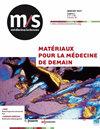终于了解了亨廷顿舞蹈症!]
IF 0.4
4区 医学
Q4 MEDICINE, RESEARCH & EXPERIMENTAL
引用次数: 0
摘要
一项利用大量单细胞研究的美丽工作阐明了亨廷顿氏病的机制:(CAG)n束的体细胞扩张,起初非常缓慢,但一旦达到临界重复长度,就会加速,驱动纹状体神经元基因表达的广泛变化,最终导致细胞死亡和纹状体萎缩。这解释了该疾病的许多令人困惑的特征,并可能对可能的治疗和对其他三重重复疾病的理解具有重要意义。本文章由计算机程序翻译,如有差异,请以英文原文为准。
[Finally, an understanding of Huntington's disease!]
A beautiful piece of work using extensive single-cell studies illuminates the mechanism of Huntington's disease: the somatic expansion of the (CAG)n tract, very slow at first but accelerating once a critical repeat length is reached, drives extensive changes in gene expression in striatal neurons and eventually leads to cell death and atrophy of the striatum. This explains many puzzling features of the disease and may have important implications for possible therapy and for the understanding of other triplet repeat disorders.
求助全文
通过发布文献求助,成功后即可免费获取论文全文。
去求助
来源期刊

M S-medecine Sciences
医学-医学:研究与实验
CiteScore
0.80
自引率
14.30%
发文量
182
审稿时长
4-8 weeks
期刊介绍:
m/s offers high-quality review articles in French, covering all areas of biomedical and health research, in a monthly magazine format (10 issues / year). m/s is read by the whole French-speaking community, in France but also in Belgium, Switzerland, Canada, Morocco, Algeria, Tunisia etc. m/s is not a primary publication, and thus will not consider unpublished data. Most articles are invited by the Editors, but spontaneous proposals are welcomed. Each issue combines news and views on the most recent scientific publications, as well as broadly accessible and updated review articles on a specific topic, and essays on science and society, history of science, public health, or reactions to published articles. Each year, m/s also publishes one or two thematic issues focused on a research topic of high interest. All review articles and essays are peer-reviewed.
 求助内容:
求助内容: 应助结果提醒方式:
应助结果提醒方式:


